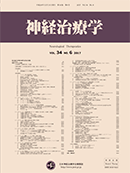Volume 38, Issue 3
Displaying 1-50 of 90 articles from this issue
-
2021Volume 38Issue 3 Pages 133-138
Published: 2021
Released on J-STAGE: January 19, 2022
Download PDF (400K)
-
2021Volume 38Issue 3 Pages 139-142
Published: 2021
Released on J-STAGE: January 19, 2022
Download PDF (403K)
-
2021Volume 38Issue 3 Pages 143-147
Published: 2021
Released on J-STAGE: January 19, 2022
Download PDF (1918K)
-
2021Volume 38Issue 3 Pages 148
Published: 2021
Released on J-STAGE: January 19, 2022
Download PDF (194K) -
2021Volume 38Issue 3 Pages 149
Published: 2021
Released on J-STAGE: January 19, 2022
Download PDF (39K)
-
2021Volume 38Issue 3 Pages 150-154
Published: 2021
Released on J-STAGE: January 19, 2022
Download PDF (446K) -
2021Volume 38Issue 3 Pages 155-163
Published: 2021
Released on J-STAGE: January 19, 2022
Download PDF (1119K) -
2021Volume 38Issue 3 Pages 164-169
Published: 2021
Released on J-STAGE: January 19, 2022
Download PDF (1737K) -
2021Volume 38Issue 3 Pages 170-173
Published: 2021
Released on J-STAGE: January 19, 2022
Download PDF (391K)
-
2021Volume 38Issue 3 Pages 174-178
Published: 2021
Released on J-STAGE: January 19, 2022
Download PDF (955K) -
2021Volume 38Issue 3 Pages 179
Published: 2021
Released on J-STAGE: January 19, 2022
Download PDF (163K) -
2021Volume 38Issue 3 Pages 180-184
Published: 2021
Released on J-STAGE: January 19, 2022
Download PDF (723K) -
2021Volume 38Issue 3 Pages 185-188
Published: 2021
Released on J-STAGE: January 19, 2022
Download PDF (337K) -
2021Volume 38Issue 3 Pages 189
Published: 2021
Released on J-STAGE: January 19, 2022
Download PDF (205K) -
2021Volume 38Issue 3 Pages 190-195
Published: 2021
Released on J-STAGE: January 19, 2022
Download PDF (1690K)
-
2021Volume 38Issue 3 Pages 196-200
Published: 2021
Released on J-STAGE: January 19, 2022
Download PDF (726K) -
2021Volume 38Issue 3 Pages 201
Published: 2021
Released on J-STAGE: January 19, 2022
Download PDF (199K) -
2021Volume 38Issue 3 Pages 202-206
Published: 2021
Released on J-STAGE: January 19, 2022
Download PDF (1252K) -
2021Volume 38Issue 3 Pages 207-212
Published: 2021
Released on J-STAGE: January 19, 2022
Download PDF (3286K)
-
2021Volume 38Issue 3 Pages 213
Published: 2021
Released on J-STAGE: January 19, 2022
Download PDF (232K) -
2021Volume 38Issue 3 Pages 214
Published: 2021
Released on J-STAGE: January 19, 2022
Download PDF (200K) -
2021Volume 38Issue 3 Pages 215-220
Published: 2021
Released on J-STAGE: January 19, 2022
Download PDF (2988K) -
2021Volume 38Issue 3 Pages 221-223
Published: 2021
Released on J-STAGE: January 19, 2022
Download PDF (1023K) -
2021Volume 38Issue 3 Pages 224-228
Published: 2021
Released on J-STAGE: January 19, 2022
Download PDF (3064K) -
2021Volume 38Issue 3 Pages 229-233
Published: 2021
Released on J-STAGE: January 19, 2022
Download PDF (915K) -
2021Volume 38Issue 3 Pages 234
Published: 2021
Released on J-STAGE: January 19, 2022
Download PDF (192K) -
2021Volume 38Issue 3 Pages 235
Published: 2021
Released on J-STAGE: January 19, 2022
Download PDF (182K) -
2021Volume 38Issue 3 Pages 236
Published: 2021
Released on J-STAGE: January 19, 2022
Download PDF (129K)
-
2021Volume 38Issue 3 Pages 237
Published: 2021
Released on J-STAGE: January 19, 2022
Download PDF (247K) -
2021Volume 38Issue 3 Pages 238
Published: 2021
Released on J-STAGE: January 19, 2022
Download PDF (161K) -
2021Volume 38Issue 3 Pages 239
Published: 2021
Released on J-STAGE: January 19, 2022
Download PDF (162K) -
2021Volume 38Issue 3 Pages 240-243
Published: 2021
Released on J-STAGE: January 19, 2022
Download PDF (537K)
-
2021Volume 38Issue 3 Pages 244
Published: 2021
Released on J-STAGE: January 19, 2022
Download PDF (234K) -
2021Volume 38Issue 3 Pages 245
Published: 2021
Released on J-STAGE: January 19, 2022
Download PDF (183K) -
2021Volume 38Issue 3 Pages 246
Published: 2021
Released on J-STAGE: January 19, 2022
Download PDF (50K)
-
2021Volume 38Issue 3 Pages 247
Published: 2021
Released on J-STAGE: January 19, 2022
Download PDF (255K) -
2021Volume 38Issue 3 Pages 248
Published: 2021
Released on J-STAGE: January 19, 2022
Download PDF (167K) -
2021Volume 38Issue 3 Pages 249
Published: 2021
Released on J-STAGE: January 19, 2022
Download PDF (190K) -
2021Volume 38Issue 3 Pages 250
Published: 2021
Released on J-STAGE: January 19, 2022
Download PDF (66K) -
2021Volume 38Issue 3 Pages 251-255
Published: 2021
Released on J-STAGE: January 19, 2022
Download PDF (1286K)
-
2021Volume 38Issue 3 Pages 256
Published: 2021
Released on J-STAGE: January 19, 2022
Download PDF (268K) -
2021Volume 38Issue 3 Pages 257-260
Published: 2021
Released on J-STAGE: January 19, 2022
Download PDF (404K) -
2021Volume 38Issue 3 Pages 261
Published: 2021
Released on J-STAGE: January 19, 2022
Download PDF (212K) -
2021Volume 38Issue 3 Pages 262
Published: 2021
Released on J-STAGE: January 19, 2022
Download PDF (162K) -
2021Volume 38Issue 3 Pages 263
Published: 2021
Released on J-STAGE: January 19, 2022
Download PDF (175K) -
2021Volume 38Issue 3 Pages 264-268
Published: 2021
Released on J-STAGE: January 19, 2022
Download PDF (1089K)
-
2021Volume 38Issue 3 Pages 269
Published: 2021
Released on J-STAGE: January 19, 2022
Download PDF (254K) -
2021Volume 38Issue 3 Pages 270-273
Published: 2021
Released on J-STAGE: January 19, 2022
Download PDF (611K) -
2021Volume 38Issue 3 Pages 274-277
Published: 2021
Released on J-STAGE: January 19, 2022
Download PDF (518K) -
2021Volume 38Issue 3 Pages 278-281
Published: 2021
Released on J-STAGE: January 19, 2022
Download PDF (1638K)
